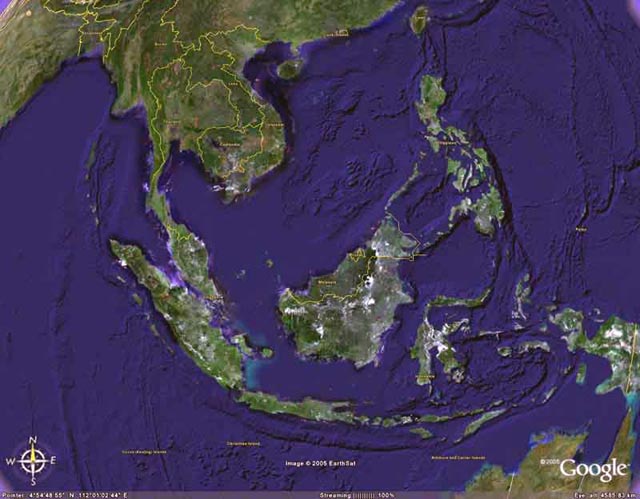
Recollections of surveying in Sarawak
By Albert (Albie) Field
Who served with 1 Topo Troop 84 Survey
Squadron RE
from December 1965 to June 1968
Borneo the third largest island in the world is situated on the equator in the South China Sea. in the north are the Malaysian states of Sarawak and Sabah, the independent state of Brunei and in the south the main part of the island, Indonesian Kalimantan. Sarawak is the largest state of Malaysia. Sarawak is separated from the mainland part of Malaysia, known as Peninsular Malaysia, by some 400 miles of open sea. Sarawak is almost as large as the whole of Peninsular Malaysia, with an area of 48,050 square miles; its coastline is about 450 miles long. The port of Kuching in the southwest is the state capital.
Kuching lies near the mouth of one of the state's many navigable rivers, the Sarawak River. The Rejang River at 348 miles is Malaysia's longest rivers; the port of Kapit, 99 miles upstream, can be reached by coastal craft., Sarawak is predominantly mountainous; Mount Murud at 7,949ft is the highest point in the state. Cloaked in dense, often virgin, rainforest, most of the interior is accessible only by river. Sarawak has a hot, humid tropical climate. Rainfall is spread throughout the year, with the heaviest concentration from November to February, during the northeast monsoon; annual rainfall averages 130-151 in. on the whole Sarawak is sparsely populated. The main centres of population are Kuching, Sibu and Miri. Sarawak is the main home of the indigenous Dayak peoples of Borneo. About half the state's population comprises indigenous ethnic groups, principally the Iban, or Sea Dayaks, the Land Dayaks. The other large ethnic groups are Chinese and Malay). The official language is now Bahasai Malay, but English is also spoken.; many Dayak still practise traditional religions. Sarawak is a mystical and magical place with an abundance of wildlife, luxuriant primary jungle and some of the most wonderful people it has been my privilege to meet and work with.
This part is my personal recollections whilst serving in Sarawak.
To give an abridged history of Sarawak; until 1841, Sarawak came under the domination of the Sultan of Brunei. At this time it was ceded to James Brooke in return for his help in suppressing a rebellion and ridding the area of pirates. The Brookes became known as the White Rajahs. In 1886 Sarawak was made a British Protectorate. In 1941 the current Rajah Charles Viner Brooke relaxed his absolute powers aiming towards self-government. During World War 2 the Japanese occupied Sarawak from 1942 to the end of hostilities in 1945. The following year the Rajah ceded Sarawak to the United Kingdom and it became a Crown colony. The formation of the Federation of Malaysia in 1963 saw Sarawak and Sabah as part of that Federation. This led to Indonesia adopting what became known as Confrontation and the United Kingdom supplied armed forces to assist Malaysia in resisting an armed invasion. 84 Survey Squadron RE had from 1956 maintained field troops in Sarawak assisting Lands and Surveys in the mapping of Sarawak these troops operated in civilian clothes for the main part. When confrontation was under way the survey units now came under the Army Command and now wore uniform. The influx of service personnel had a major influence on the survey operation. Mapping was now urgently required for operations. Air support was needed for the infantry and led to helicopter bases being established. Whereas air support had been an unusual event it now became the norm. This made life a lot easier compared with river travel and climbing hills a helicopter could drop a party on the hilltop saving many hours.
Satellite Views are from Google Earth

A map of Borneo, in the North is Sarawak
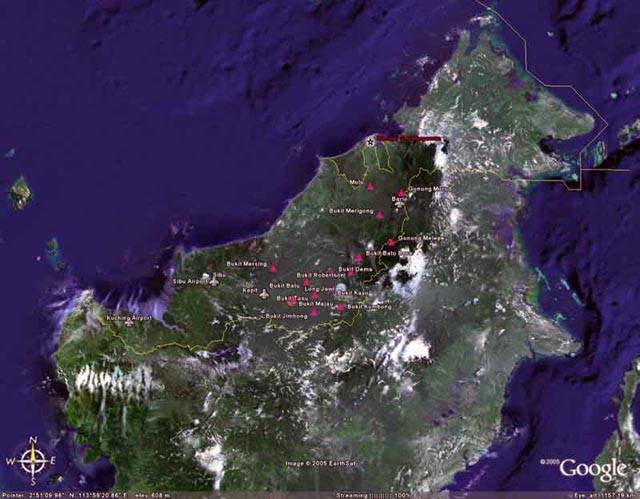
closer view of Sarawak
I arrived in Singapore on 30th November 1965 after completing a Field Survey Technician Class 1 course at the School of Military Survey and leaving behind my new son of only a couple of months. My classification was now Surveyor Trignometrical class 1 with the rank of corporal. We were late arriving due to an aircraft malfunction which had made necessary a 19 hour wait in the airport lounge at Kuwait (far from the most pleasant experience and not recommended). My new unit was to be 84 Survey Squadron Royal Engineers; my Officer Commanding was Major R.W. Busk RE. I arrived together with Corporals Peter Worsnop and 'Streak' Hobson both of whom had been on the same upgrading course; the former was posted to Survey Directorate and the latter to 84 with me. Streak was detached to 2 Topographical Troop at Labuan and I was to be detached to 1 Topographical Troop based at Sibu, the major town in the 3rd division of Sarawak.
My interview with Major Busk was interesting; his questions included can you abseil? Have you used helicopters? Can you speak Malay and ended up with can you cook? I was only able to answer the final question in the affirmative.
I arrived in Sarawak on 10th December 1965 at Kuching airport on a Royal Air Force flight in an Argosy from Singapore. Kuching is the capital of Sarawak. I then travelled to Sibu on a Malaysian Airways Flight. Lieutenant Roy Wood the troop commander together with his wife Sue met me at Sibu airport. Lieutenant Wood affectionately known by our Ibans as Tuan Kayu was to rise to the very top and become Director of Military Survey in the rank of Major General. They took me to the unit HQ at Bukit Lima, there was no one else in and I wondered what I had come to. I had never experience the like before. Later that evening two unit members, Staff Sergeant Mick Pooley and Corporal Roy Doubtfire arrived and introduced me to the nightlife of Sibu. We consumed a few bottles of Tiger beer and I returned to Bukit Lima.
I believe it was the next day but cannot be sure after this time some more troop members arrived; I think Jim Cumpsty and Malcolm Scott were amongst them. From them I found out that most of the troop’s time was spent at the forward base situated at Nanga Gaat, which was about 150 miles from the coast along the river REJANG, the major river in Sarawak. This forward base also housed a company of the resident infantry battalion at present the Kings Own Scottish Borderers, 110 Squadron Royal Air Force and their Whirlwind 10 helicopters and elements of the Police Field Force and The Border Scouts both of which were locally enlisted units.
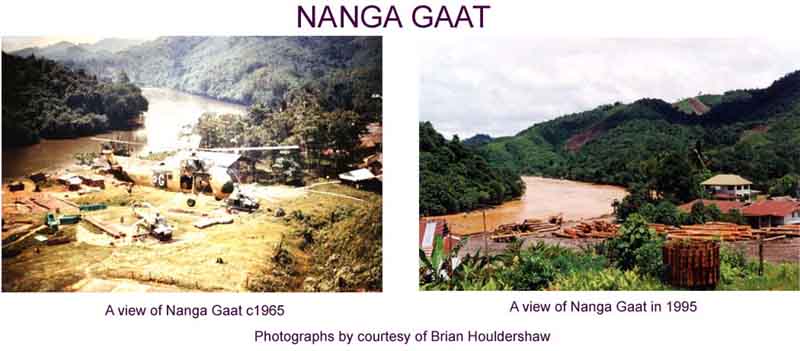
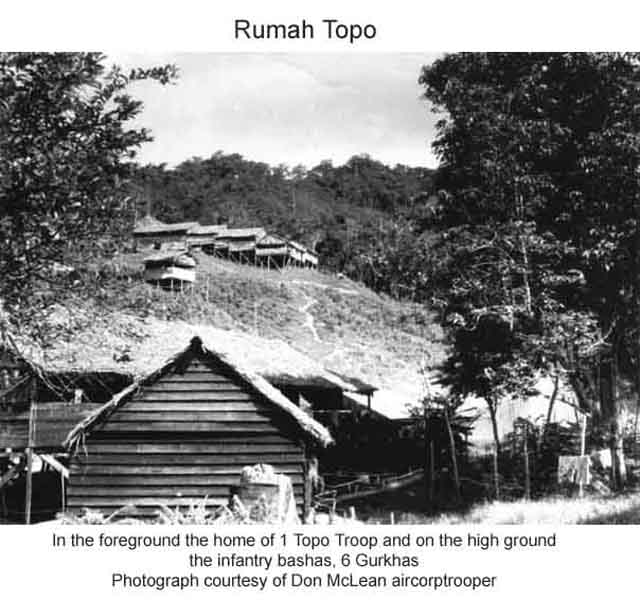
The small stilted hut on the Hill, was the control tower for the Helicopters. Used in the main by RAF 110 Squadron, but also by 3 Flight Army Air Corps.
Later this was taken away and we had to sit in a roofed over, dug out. Very typical of a first world war command post. But a lot hotter! comment by Don!
After a few days we all travelled to Nanga Gaat in a longboat powered by a 40HP Johnson outboard engine and driven by one of our Iban Labourers, I believe he was named Kenyan. This was the first of many forms of transport that I was to use between Sibu and Kapit. I was later to travel by Speedboat, the Sin Kapit 1 & 2 and by air in a Twin Pioneer. We called at KAPIT on the way to buy provisions from a Chinese shop. Kapit is a town on the REJANG and the last place of any size; I was amazed to find what was available in the local shops. We eventually arrived at Nanga Gaat just as darkness was falling and were lucky not to be greeted by shots from the resident infantry platoon the Kings Own Scottish Borderers. I found out that we as a troop employed local Ibans as labourers, they were paid the princely sum of 4$ Malaysian a day, at that time the exchange rate was approximately 8 dollars to the pound. This meant that they had roughly £3. 10s a week. This appeared to us to be a small amount but was to them a small fortune. I also found out bout the “hearts and Minds” campaign that was continually in progress. One aspect of this was the clinics held for the local population at the medical centre
That night I was taken to one of the local Iban Longhouses, I believe it was Steve Fulford who introduced me to this new experience; it was one that I would enjoy many times more in the future.
It wasn't long before I was introduced to the Whirlwind 10 choppers of 110 Squadron Royal Air Force and flying out with Bob Barkhouse and some Ibans to a hill named Bukit Koh, part of the Ulu Danum traverse. Once on the hill we prepared to observe with tellurometers MRA2 and a Tavistock 5” geodetic theodolite. For the younger amongst us who have been brought up with the modern satellite tracking technology which would have made the duration of the surveys much less I will briefly describe these instruments. The tellurometer is electronic measuring equipment, which utilises microwaves. The MRA2 emitted a carrier wave of 3 GHz or 10cm and by measuring the phase difference of different modulations on a cathode ray tube it is possible to obtain the time it takes a signal to be sent and return. Knowing the speed of radio waves it is possible to convert this time to a distance. There was another aspect of this equipment which was extremely useful to us and that was the voice communication between sites.
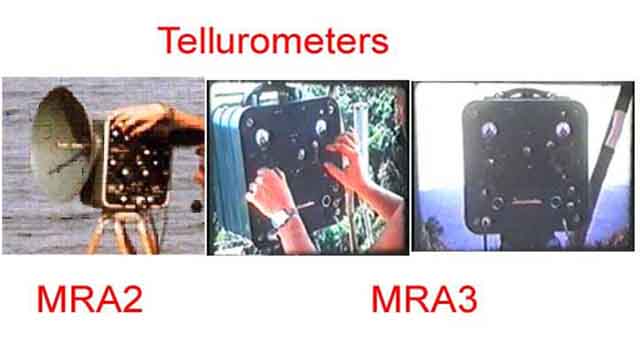
The 5” geodetic Tavistock theodolite permits the reading of horizontal and vertical angles to an accuracy of 0.1 seconds of arc. The standard to which we made our observations was first order. Angularly we took sixteen rounds of horizontal angles and when measuring distances four rounds of vertical angles as simultaneous reciprocal. Distances were as far as I can remember measured four times in each direction with eighteen fine readings at the same time it was necessary to take meteorological readings comprising dry and wet temperatures and pressure. These were taken using either an electrically aspirated or hand held hygrometer and a baromec barometer.
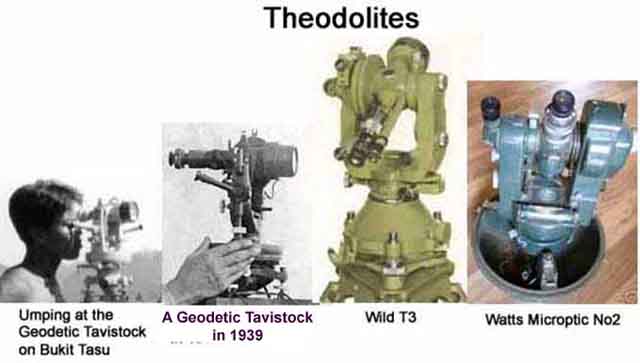
It wasn't long before I realised that my training had been inadequate, not from the technical side, there is no better training in survey than that received at the School of Military Survey. However I knew nothing about radio procedure and it was a matter of learning on the job. In fact it wasn't until 1967 when a new voice procedure was introduced that I had any formal training in this aspect of the job. This was completed at 15 Signals Regt. in Singapore. During the stay on this hill I was introduced to eating wildlife shot by our Ibans, I shall never forget the first time that I ate monkey meat, tough but tasty. I also discovered that I just couldn't eat nasi (boiled rice) I just gagged, but if then stir fried I had no problem Anyway the time on the hill came to an end and we were picked up by a Whirlwind 10 from Nanga Gaat, I found the method of leaving or should I say lifting off and falling down the side of the hill frightening in the extreme. . It was my first experience with helicopters before apart from the lift out to the hill. I am not sure if the hill had been occupied before, as I cannot recollect clearing any trees away for visibility. But as it was 39 years ago I do not expect memories to be that clear. Other equipment we used included lamps signal survey, the replacement for lamps beacon survey, in my opinion a much inferior replacement which were set out eccentrically to be observed by the other stations In addition we usually set a Chinese copy of the Tilley lamp above the point and very often this proved to be the ideal signal.
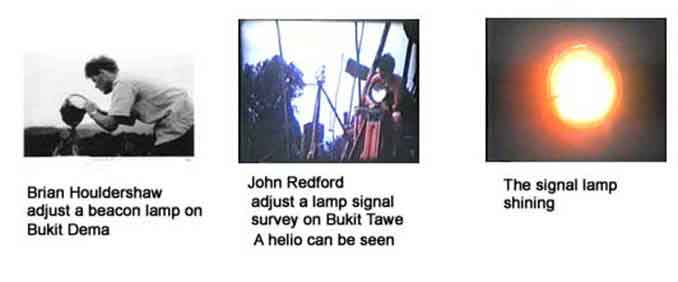
In order to keep in touch with our base we were using B156 transceivers borrowed from either the Police Field Force or the Border Scouts I am not sure which. They were far superior to the 88 sets available to us and contact with the C11 transmitter and R210 receiver (borrowed) at Nanga Gaat was often successful, it only needed one station to make contact with base as we could use our tellurometers between intervisable stations to relay any messages. We carried 9mm L2A3 Sterling sub machine guns as personal weapons.
As Christmas was approaching the troop then moved back to Bukit Lima for a short break. Christmas dinner was prepared by our new cook Phil Fidler who was newly arrived from Singapore; it was as far as I can recall Great. I also remember going to a party at the home of one of the married troop members, Andrew Thomas and his wife Margaret.
My next foray into the field I remember was in the company of Charlie Hilder, the name of the hill escapes me but I know we took 7.62mm L1A1 Self loading rifles rather than the usual Sterling sub machine gun. This was because the hill was extremely close to the Indonesian border and the Self-loading rifle had more stopping power than the Sterling. To the best of my memory the hill was mainly rock and very exposed.
I can only remember one more hill before we returned to Bukit Lima and that was Bukit Majau a trig regularly occupied overlooking Nanga Gaat, on this one I took a 38 revolver for target practice.
Click button below for more details of Nanga Gaat
All this surveying had been in the 3rd Division and the next phase of the surveys was to take us further north into 5th Division, but before this we regrouped in Sibu and were issued with the latest Tellurometers MRA3, brand spanking new. At Bukit Lima we familiarised ourselves with this new and superior equipment before setting off on what was to be a three or four month stint in the field.
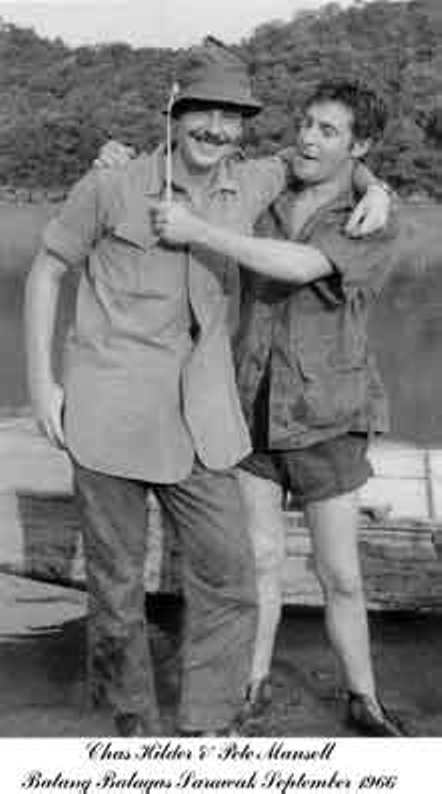
Chas Hilder and Pete Mansell, two of my companions on hill tops
I believe it was on my next hill that we staged at Long Jawi on the way out and had to spend the night there as the pilot clipped his tail rotor on landing and had to wait until the next day for a replacement and for repairs to be completed. I think that night must rank amongst the worst that I have known; we were eaten alive by mosquitoes and midges. The pilot didn’t stay but was flown back to Nanga Gaat. My companion now was Pete Mansell. We were landed at a riverbank to climb to our new location, clear the hill and observe as necessary. It was a very enlightening experience as close to where we had landed was a Punan settlement or should I say hut at which we stayed for a few days. Whilst there our mandor Moris went out hunting with the headman, Moris with his trusty Stevens shotgun and the headman with a blowpipe. When they returned they were carrying a wild pig, Moris was a very good hunter but in this case it was the Punan who was successful. The hilltop took a lot of clearing and in the process disturbed a lot of flying insects; they seemed to get everywhere. In the ears, eyes and mouth, others with a diamond shape to the rear area were very fond of biting. We found that the new tellurometers performed very successfully and were soon ready to be picked up and moved to our next location.
This was to be a hill named Bukit Merigong previously used by Lands & Surveys. We staged at long Banga but were no longer using 110 Sqn of the RAF but were now serviced by 848 NACS from Bario with what I believe were Wessex V's. Pete and I were to spend a month on this hill but with only 4 Ibans instead of the six we had had up to now. On the very first night we could see all hills needed but only one was showing a light, that of Andy Thomas at Bukit Batu Bora, we could see lights at Gunung Melepe but this was obviously inside the basha the next morning Jim Cumpsty reported that he hadn't shone a light because the concrete wasn't dry! At the ranges we were observing, in excess of 50km a small centring error would not really have mattered, as 0.1 seconds would subtend 2.4cm at 50km. Alf Isherwood and Bob Barkhouse said the same about Gunung Murud; it was a full month before we were able to observe angles! Andy at Bukit Batu Bora and I observed what we both believe to be the longest line measured with a MRA3 at 97km.The next move was for Andy and ‘Sid’ Hoyland to go to Gunung Mulu, they made contact over 125 km to Melepe but couldn't measure.
Trigs observed from Bukit Merigong (1465m) were Bukit Batu Bora(1465m), Gunung Melepe(1908m), Gunung Murud(2423m) and Gunung Mulu(2375m). We were re-supplied from Bario several times during our occupation of the hill, rations were now in the main "compo" 10 man ration packs, designed to feed ten men for one day. Some of the offerings were more popular than others, sausage and beans not being one of them! Hunting at this location was not very good.
We then were recovered to Bario, an airstrip on a plateau at about 1000m, to find that Tuan Kayu had given all our beer ration to the Navy and no further supplies had been successfully air dropped WE WERE NOT HAPPY!!!! There should have been a supply in plenty of time but operational needs had prevented it. As it was we had to make do with Ghurkha rum in the Navy bar. It was a relief to be able to have a proper shower and shave, the only showers on the hill tops were to stand out in the rain with a bar of soap. Another luxury to which we were not accustomed was to be able to sit on a toilet instead of leaning out backwards over the edge of the mountain!
After a day or maybe two Pete and I moved to Gunung Murud at 2423 metres Sarawak’s highest Mountain. I seem to recall that we did not take any of our Ibans with us, but that may well be a memory failure!
There was a Ghurkha signals relay station at the top in a wooden hut and another wooden hut where we made our home until the work was completed. The occasional Ghurkha rum was most welcome, as it seemed very cold, although the minimum was only 54F after what we were used to it was cold! We not only used our sleeping bags but supplemented them with blankets. On this mountain we were lucky enough to have one of the older lamps beacon survey which operated from a 6 volt supply with a maximum wattage bulb of 24W, this gave a much superior performance when compared with the 0.5A 6V (3W) bulb of the lamp signal survey.
Then Pete and I moved to a hill that had been cleared by Sapper 'Stan' Stanley and his gibbon Stamps. We couldn't believe it! The helicopter pad was about 3ft square sticking out from the side of the hill and stumps about a metre high left in the cleared area. It was on this hill that Lassah was walking ahead of me suddenly swung his parang and said 'that ones dead' I can't remember the Iban wording but I believe it was dia suda mate. (Or some such words) It was a banded krait, rather deadly.
Back to Bario and ready to leave 5th division back to third division with another hill to occupy on route.
This started for our party with a frightening experience. We loaded up the Wessex and the crewman kept saying, “Keep it coming” until the whole party and kit was aboard. I think it was Pete, four or possibly six Ibans and I. Umping and Boong were amongst the Ibans. Starting half way down Bario's airstrip (at 3000ft altitude) the pilot tried a running fixed wing style take off, got to the end of the runway stopped , turned and went back to the other end. He then tried again, this time staggered into the air and slowly lifted to try and clear the surrounding hills, the chopper was vibrating and the crewman shut the door something we hadn’t had happen before, Umping went white! We eventually made it, then we landed at Long Banga prior to moving to our new location the pilot then told us he was 500lb overweight at take off and had jettisoned fuel in order to clear the hills !!. We were dropped beside a river. We then had to make camp and then started walking to find a spot where we could see the points that we were to observe after a lot of walking we found a spot which should do. There was a lot of wildlife at this site, Pete saw an Orang Utan across the river. We saw tracks of what we believed to be an Iguana. I went out to spend a penny one morning and found myself urinating almost on a python. When we measured it was found to 18ft long. The python was suitably dispatched and provided dinner that night. One day I went out hunting with Umping, he was about to shoot a monkey when his shotgun misfired and jammed, it took three shots from my Sterling to drop it. That just showed the limited stopping power of the Sterling but it provided a meal that evening. Whilst at this camp which was on a riverbank the lads had obtained a chicken which provided us with fresh eggs. That is until we were visited by a feline creature that I believe was a clouded leopard; unfortunately our Ibans surprisingly could not identify it. It is only after many years and access to the WWW that I found a resemblance to it, if memory serves me well I thought at the time that it was an ocelot. This was a location where we fed well due to the abundance of wildlife We eventually finished our work there and were lifted out to Kapit, as Nanga Gaat was no longer in use with the end of confrontation. I actually boarded to chopper bleeding from the top of my head. I had been holding the Very pistol above my head and the kickback had hit me on top of the head.
Pete was taken straight back to Sibu but I had a further night at Kapit staying a Chin Kitt’s hotel. I flew back to Sibu the next day where my wife was now living with my daughter Stephanie & Stephen who was now almost walking. It is my regret that I now moved into an administrative position and did not have the enjoyment of working in the field to such a degree.
Roy Wood was replaced as Troop Commander by a Captain of the Royal Australian Survey Corps. The least said about him, the better. With Roy leaving the troop also lost its secretary and another Australian Mrs Mac took over the job. 58 Brigade had now left and the Royal Malaysian Army took over security. We no longer had Redcaps wandering round the nightspots!
During 1966 under our Australian Commander the troop went to Kapit complete with families for the annual regatta. I met many of the Ibans who we had used at this time. During 1966 under Capt. Etheridge the troop went to Kapit complete with families for the annual regatta. I met many of the Ibans who we had used at this time.
The Australian was replaced by Lieutenant J. Elder, Royal Engineers during 1966. The only time that I was able to return to Nanga Gaat was towards the end of our sojourn in Sarawak. I together with our SQMS. who was in Sibu to help organise the return to Singapore had a trip up river and spent the night at Rumah Tingang. Happy days!

The troop left Sarawak on 20 January 1967, families travelled on a RAF Hercules, sorry that should read Beverley, my mind was going back to the days of OP Emily! The stores were accompanied by the single members of the troop on a LST (landing ship tank) leaving on 26 January 1967.
A few links that may be of interest.
Survey in India
http://www.britains-smallwars.com/India/Survey.htm
Small wars Index
http://britains-smallwars.com/main/index1.html
135 Sqn website
http://www.reserve-forces-london.org.uk/units/1080/default.htm
Surveying Instrument collection from UNSW
http://www.gmat.unsw.edu.au/currentstudents/ug/projects/f_pall/html/index.html
Malaya/Borneo 1948-1966 index
http://members.tripod.com/Askari_MB/index.htm
Brian Houldershaw’s write up
http://www.nmbvatyneside.org.uk/newsletter2003page2.htm
Bario & the Kelabits
http://www.geocities.com/RainForest/Vines/6980/bario_1a.html
Kapit
http://www.isarawak.com.my/kapit/
People of Sarawak
http://www.sarawaktourism.com/people.html
The Vanishing tribes PUNAN
http://www.takumedia.net/punan.htm
Royal Navy commissioning books (PDF files long download from this index)
http://www.axfordsabode.org.uk/comishbk0.htm
The Ibans of Sarawak
http://www.geocities.com/RainForest/Vines/6980/lnghouse.html
Singapore Photo gallery
http://www.molon.de/galleries/Singapore/
Malaysia Photo gallery
http://www.molon.de/galleries/Malaysia/
Royal Engineers Forums
http://www.royalengineersforums.co.uk/
|
Malay |
English |
| Gunung | Mountain |
| Bukit (Bt) | Hill |
| Sungai | River |
| Nanga | Junction |